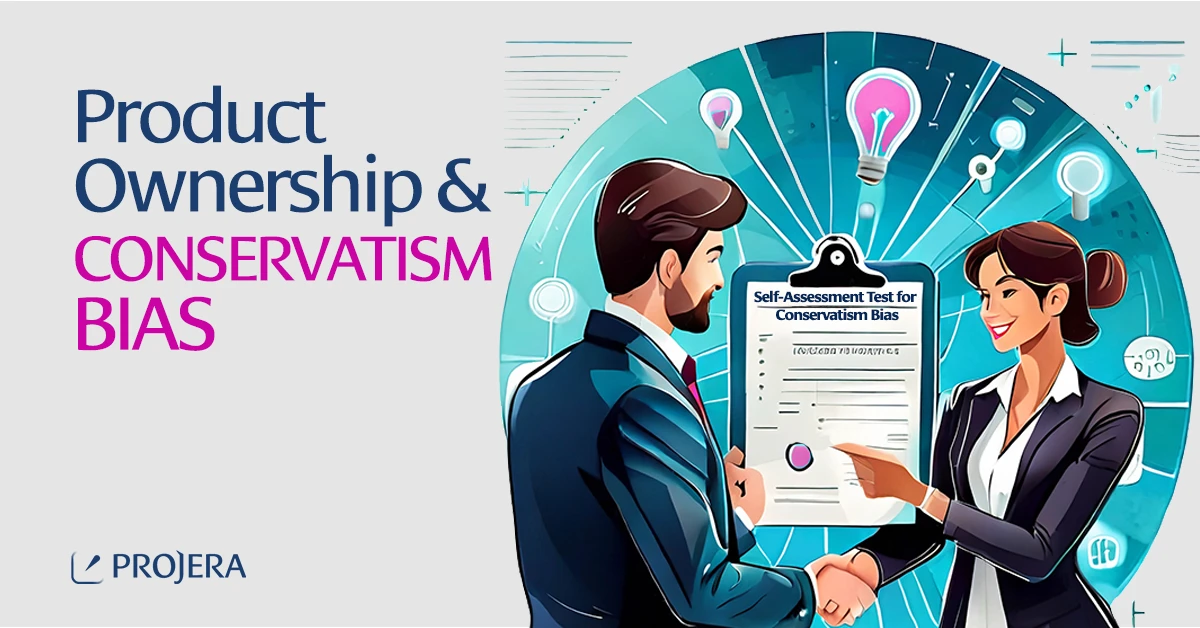
Product Ownership & Conservatism Bias
Conservatism bias refers to a cognitive tendency where people are overly cautious and prefer maintaining their existing beliefs, views, or strategies, even when faced with new evidence or information that contradicts or challenges them. This bias often leads to underreacting to new information or resisting change, as individuals or groups show a preference for the familiar and a reluctance to revise their views.
What is conservatism bias’s scientific background?
The concept of conservatism has been observed throughout history, though it may not have been formally named as such. Philosophers and thinkers have long noted the human tendency to resist change and cling to familiar beliefs and traditions. The formal identification and naming of conservatism bias as a specific cognitive bias are more recent, emerging from the field of psychology and behavioral economics. This development occurred particularly in the 20th century as researchers began to systematically study how humans process information and make decisions. Pioneering studies by psychologists and economists like Daniel Kahneman and Amos Tversky in the 1970s and 1980s were instrumental in identifying and naming various cognitive biases, including conservatism bias. Their work in prospect theory and judgment under uncertainty highlighted how people’s decision-making is often irrational and influenced by various biases. Today, conservatism bias is well-recognized in various fields, including psychology, economics, and finance. It is understood as a barrier to innovation and adaptability, impacting everything from individual beliefs to market dynamics.
Why do have it?
The motivation behind conservatism bias involves a combination of psychological, emotional, and cognitive factors. This bias is rooted in the human desire for stability, predictability, and the avoidance of uncertainty. Several key factors contribute to its manifestation:
- Cognitive dissonance reduction
- Preference for familiarity
- Information processing limitations
- Emotional attachment
- Perceived risk of change
- Overweighting of past experiences
Some people are naturally more open to new experiences and change, while others are more cautious and prefer stability. Traits like openness to experience, tolerance for ambiguity, and adaptability can influence how prone an individual is to conservatism bias. Individuals with a higher need for cognitive closure, who seek definite answers and dislike ambiguity, may be more inclined towards conservatism bias. Conservatism bias can also be a psychological defense mechanism to maintain a sense of control and stability in one’s environment. Moreover, people strive for internal consistency in their beliefs and attitudes. When new information challenges this consistency, conservatism bias helps maintain mental equilibrium.

Product Owner & Conservatism Bias
A Product Owner being stuck in conservatism bias can have significant implications:
Resistance to Change: Product Owners might resist incorporating new customer feedback, market trends, or technological advancements into the product development process. This resistance can hinder innovation and adaptation, key elements in today’s fast-paced and rapidly changing business environments.
Ineffective Decision-Making: Conservatism bias can lead to sticking with traditional methods or past strategies, even when they are no longer effective. This can result in poor decision-making, as the Product Owner might overlook or undervalue fresh, potentially more effective approaches.
Impaired Product Evolution: In agile development, the ability to pivot and adapt is crucial. A Product Owner with a conservatism bias may struggle to make necessary changes to the product backlog or roadmap in response to new insights or shifting priorities, leading to a product that doesn’t fully meet user needs or market demands.
Team Dynamics and Morale: If a Product Owner is consistently conservative in their approach, it can affect team dynamics. Team members might feel their innovative ideas are not valued or explored, which can lead to decreased motivation and creativity within the team.
Market Competitiveness: In a competitive market, an inability to quickly adapt can leave a product or company behind. A Product Owner’s conservatism bias can slow down the response to competitors’ moves, leading to a loss of market share or relevance.
To counter conservatism bias, Product Owners can adopt strategies like actively seeking diverse perspectives, encouraging open and continuous feedback, being willing to experiment and take calculated risks, and fostering a culture of learning and adaptability. Regularly reviewing and updating beliefs and strategies in light of new data and experiences is also essential for effective product management.
Self-Assessment Test for Conservatism Bias
Here’s a self-assessment test designed for a Product Owner to evaluate if they are under the effect of conservatism bias. The test consists of a series of statements. The Product Owner should rate each statement on a scale from 1 (strongly disagree) to 5 (strongly agree). This scale will help identify tendencies towards conservatism bias in their decision-making and approach to product management.
Rate each statement on a scale from 1 (strongly disagree) to 5 (strongly agree).
- I often find myself sticking to the original plan, even when new information suggests a change might be beneficial.
- When faced with new market trends, I prefer to wait and see rather than quickly adapting our product strategy.
- I tend to prioritize my own beliefs and past experiences over fresh customer feedback or new market research.
- I often feel that customer feedback is less reliable than our existing data and past successes.
- I am hesitant to experiment with new ideas, preferring to stick with proven methods and features.
- The idea of changing a well-established feature or product strategy based on new suggestions makes me uncomfortable.
- I find it challenging to change my mind about product decisions, even when presented with compelling new evidence.
- When new data conflicts with my previous beliefs or decisions, I usually find reasons to discount the new information.
- I am skeptical about innovative suggestions from the team that deviate significantly from our current roadmap.
- I believe that maintaining consistency in our product strategy is more important than exploring untested ideas from the team.
- I tend to downplay the significance of new competitors’ moves or market shifts, relying more on our established strategies.
- Adapting to competitor innovations is not a priority for me unless there’s substantial evidence of their success.
We need both
20-30: High likelihood of conservatism bias. You may be overly reliant on past information and resistant to change, which could hinder innovation and adaptability.
10-19: Moderate conservatism bias. While you have some tendencies to stick with the familiar, you also show openness to new information and change.
5-9: Low or no significant conservatism bias. You seem open to new ideas, adaptable to change, and willing to incorporate new information into your decision-making process.
If your score indicates a high or moderate level of conservatism bias, consider strategies to enhance adaptability and openness to new information. This might include seeking diverse perspectives, fostering a culture of experimentation, and regularly challenging your own assumptions and decisions.



